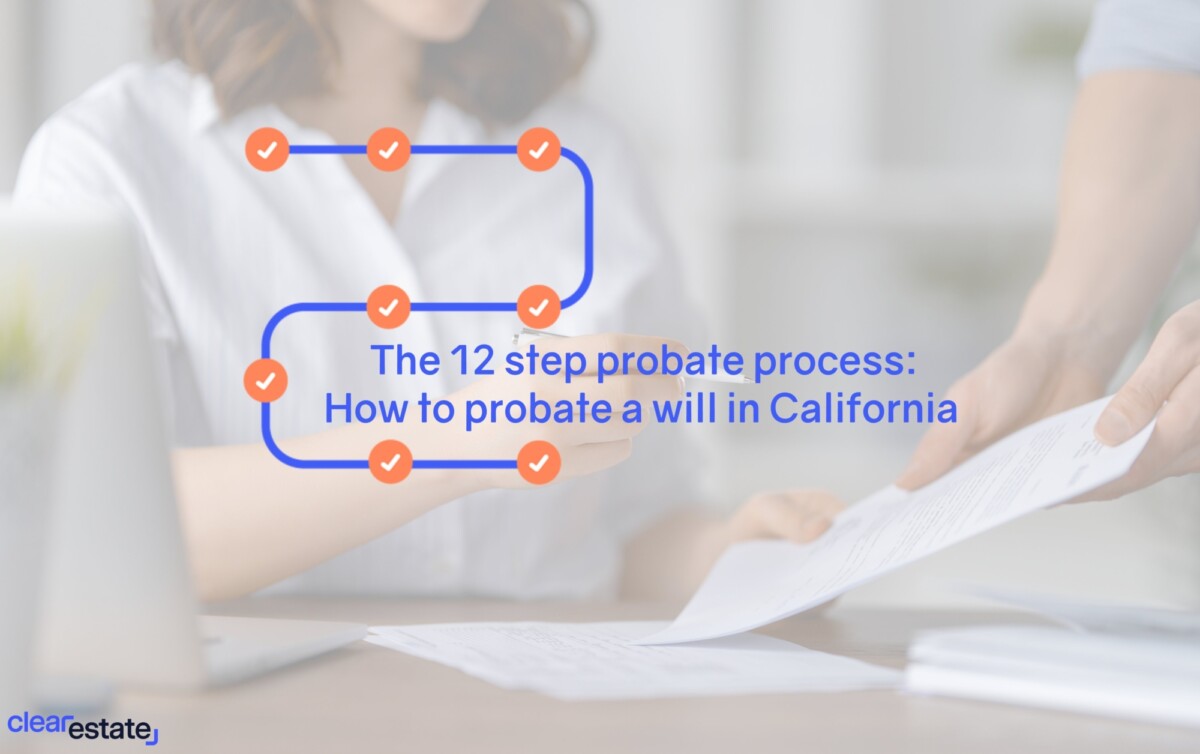Estate Settlement
Apr 25, 2024
Mineral Rights in Texas When Someone Dies
Explore how to transfer, inherit, or sell Texas mineral rights after a death and secure royalties.


A loved one, or someone that you were close to, has passed away and you, as the Executor, are legally responsible for spearheading the legal process that will distribute their assets, including any real estate, to their intended heirs.
In fact, you may be one of the heirs who will possibly be receiving a car, home, jewelry, artwork, money, or any other personal property that was owned by the person who died.
As the appointed Executor (hereinafter called the ‘Administrator’, as is standard in California) of the estate, and assuming that the deceased wasn’t your spouse, you are required to undertake the probate proceeding of the deceased’s will through the California Probate Court system.
California’s Judicial Branch operates under the auspices of the Superior Court of the county in which the deceased resided.
Before any assets are distributed to survivors, there are several specific steps that must be completed, including filling in any forms for filing. These are quite clear in nature, but they must be completed exactly as required, and most importantly, in the exact order that the Court specifies.
These are the mandatory steps, in order, of the California probate process. However, be sure to review the order of the specific county probate process for the county that you are filing in, as some steps may be ordered slightly differently.
The petition must be filed in the county of residence for the deceased at the time of death. Upon making the filing (California form DE-111), the Court will officially be notified that a hearing needs to be scheduled regarding this matter. Typically, this takes place in about 30–40 days.
IMPORTANT NOTE:
Following the filing of the probate petition, and as soon as is practicable after receiving a hearing date from the Court, a notice of the upcoming meeting must be published in the local newspaper a minimum of three times.
If there is a will, everyone named in it must be mailed a copy of the hearing notice. Additionally, all legal heirs of the deceased, whether they are mentioned in the will or not, as well as potential creditors, must receive by mail, a copy of the hearing notice.
At the initial probate hearing, the court decides who will be the Executor/Administrator/Personal Representative for the estate. These titles are interchangeable, but Administrator is more widely used in California.
In the probate petition, you may suggest who you believe the Administrator should be. Assuming that there was a will left by the deceased, the person named in it as Executor will, in all probability, be appointed by the Probate Court to represent the estate.
If there is no will, meaning that the deceased died "intestate," or, if the Executor designated in the will chooses not to serve, then the Probate Court proceeding will rely on the Court to appoint an Administrator to lead the process. The closest living relative, or someone who will probably be a beneficiary, are the most likely candidates to be appointed.
It is likely that the Probate Court will require the Administrator to post a surety bond. If so specified, this must be completed with an authorized bond company before the Clerk of the Court will issue the "letters testamentary," also known as "letters probate" or "letters administrative." These documents grant the Administrator the legal authority to proceed in handling the decedent’s estate.
The Court’s stipulation that the Administrator is bonded is to ensure that they execute their fiduciary responsibilities properly and completely. Bond prices are based on several factors, most importantly the amount that the Court requires, as well as your personal creditworthiness. If the Administrator lives in a state other than California, a bond will be required. You may, however, request a reduction in the amount of the bond if the Court can be assured that a large amount of the estate is secured by a savings account that is not subject to outstanding liens, and that it can only be accessed by a Court order.
The cost of the bond can be claimed as an expense by the Administrator and will be reimbursed when the estate is opened. Since the bond, if required, must be purchased before being officially assigned as the Administrator, that expense must initially come from personal funds.
Proving a will means convincing the Probate Court that the will in question was undoubtedly authorized by the deceased person. In most cases, this is a smooth process, a formality, as the will would have been signed and dated by the deceased, with two or more witnesses present at the time.
The witnesses, who cannot be designated beneficiaries of the Will, should also have signed an attestation clause, making the will "self-proving." The Administrator can submit a self-proving will to the probate court, and no added testimony is needed to assure its validity.
On occasion, a Holographic Will (handwritten) is left by the testator/deceased, rather than a typed document. To prove that the handwriting is that of the deceased party, the court usually requires sworn testimony from someone who knew the deceased, and their handwriting, well.
A third type of will that the Court will accept is a statutory will. This is a pre-printed form that the now deceased person, or a representative, completed by filling in the blanks provided. This form needs to have been developed in accordance with California law, and again, signed in front of no fewer than two witnesses who are not designated beneficiaries of the will.
As the estate administrator, one of your most important responsibilities is to collect all of the eligible probate assets of the deceased; which may include personal property, vehicles, bank accounts with no beneficiaries, etc. Items that may not be included as probate assets include estate property, retirement accounts (IRA, 401k) that already have beneficiaries designated, property contained in a living trust, and funds/securities that are in pay-on-death accounts (POD) or transfer-upon-death accounts (TOD). If a beneficiary has pre-deceased the bank account holder, these items may be included in the probate case with the Court’s approval.
If the title (ownership) of an asset held by the deceased is required to be changed into someone else’s name, the Administrator must make these arrangements. Usually, to process a transfer of title, a death certificate must be presented.
The types of assets that may require a legal title change include, but are not limited to, stocks and bonds, bank and credit card accounts, brokerage accounts, and mutual funds.
Additionally, physical assets, ranging from the deceased’s primary residence, condos, vacation homes, motor vehicles, boats, aircraft, motorhomes, etc., will probably require the title to be transferred. Any transfer of property must be available for public review.
California form DE-160, Inventory and Appraisal, must be filed with the Court by the Administrator (personal representative). This form is your personal declaration that the items specified in the form are each and every asset in the decedent’s estate.
With rare exceptions, the Court will assign a Probate Referee or will require you to contact an authorized Probate Referee, so that any non-monetary assets can be professionally valued. If you do need to find a Probate Referee, be sure to contact someone who is court-approved for the county where the probate hearing is taking place.
The Administrator provides notice to creditors with a formal notice of the decedent’s passing with form DE-157, Notice of Administration to Creditors. Following its receipt, creditors may submit a written claim against the estate. Claims that are determined to be valid will be paid from the estate before any other distributions are made. This includes funeral expenses and any other outstanding bills.
California law requires creditors to submit all claims no later than four months after the Administrator has been appointed.
At the second hearing, if all has gone to plan, will involve the judges decision on final distribution of the estate.
If real estate owned by the decedent is sold (liquidated), the Administrator may be required to file a form DE-260, Report of Sale and Petition for Order Confirming Sale of Real Property.
Ensuring that the deceased's personal income tax return has been filed, estate taxes and fees are paid, including Attorney fees, accounting fees, Federal and California imposed taxes.
If you need help calculating statutory probate fees in California, we've created a calculator to help you understand the attorney fees and executor compensation - you can access our probate fee calculator by clicking: here.
It is important that the estate taxes are paid on time, as the estate administrator may be held liable for not filing tax returns on time, or mismanaging estate assets. The Court may decide to impose personal liability on the estate administrator if they feel they have neglected this aspect of probate.
In this step of the probate procedure, the complicated and potentially long probate process is nearing completion. Closing the estate entails the Administrator providing a complete and final accounting that they have taken in this regard. The required petition that is filed as the concluding action of the Administrator will summarize all the actions that have been taken on behalf of the estate.
To conclude probate, a hearing is scheduled for the report to be presented to the Judge, who will in turn review if the Administrator has handled everything correctly and undergone careful accounting. The Judge will probably require receipts to show that the balance to beneficiaries has been paid and that any distribution of property to beneficiaries has been made. When the Judge is satisfied that all of the aspects of the probate filing have been successfully completed, the court will "discharge" the Administrator from his or her responsibilities.
Any appeal to the judgment must be filed within 60 days of the mailing or personal service of the entry of judgment.
As probate is a court-supervised process and with all of the above requirements necessary to complete it, you’re no doubt wondering if this will be a lengthy process. Depending on the complexity of the decedent’s estate, you can expect it to take anywhere from six months to possibly even two years. Should any unforeseen problems or unfavourable decisions (to some) arise, the process will be longer, however, if it is a simple estate to settle, everything should be processed quickly.
** Important to note for executors:
If you have any questions regarding the probate process you can reach out to us; we're estate professionals specialized in probate administration in California. Alternatively, you can download our free 12 step blueprint to probating an estate in California below:

 Take the Guesswork Out of Probate
Take the Guesswork Out of Probate
Join the 100,000+ executors who have downloaded our free step-by-step blueprint to probate.
Download Now